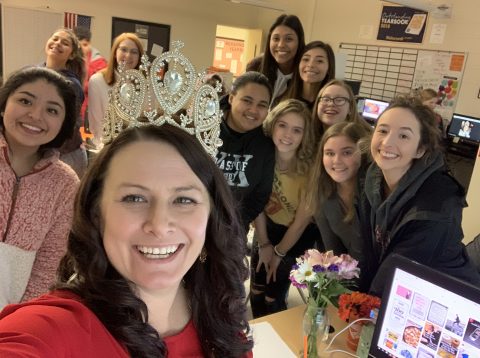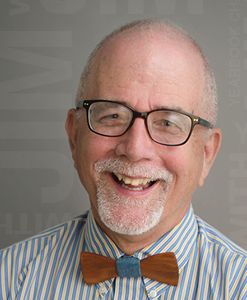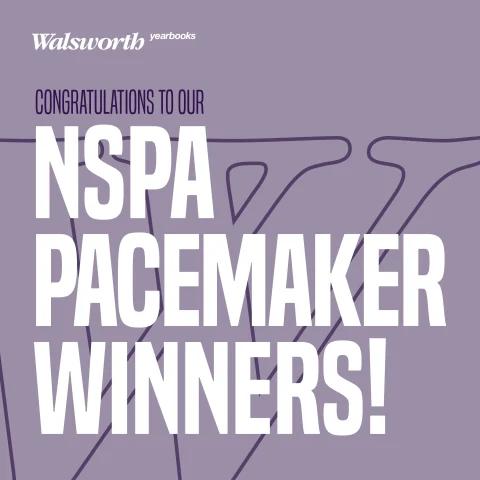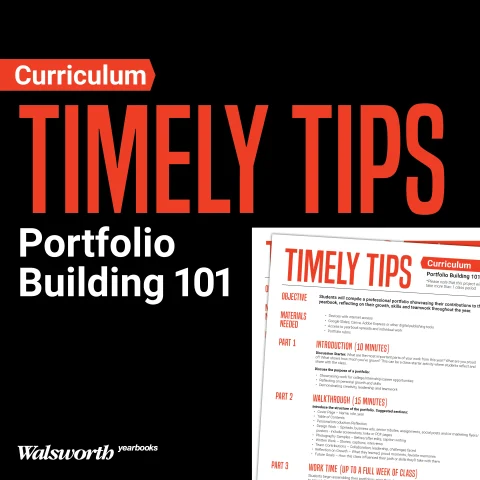We’re back with a summer edition of Advisers of Note and this time I spoke with Michelle Shue, the yearbook adviser at Davie County High School in Mocksville, North Carolina. Take a look at her amazing success story!
Profile
Michelle Shue
Davie County High School, Mocksville, North Carolina
High school attended: I graduated in 1994 from North Iredell High School in Olin, North Carolina. It’s a small school in the middle of rural North Carolina, home to the dairy capital of the East Coast.
College attended: I went to college first at Peace College in Raleigh, North Carolina, earning an Associate of Arts degree. Peace has since made the move to become a co-ed, four-year college, but it was still a two-year all women’s junior college when I attended from 1994-96. I transferred to UNC-Chapel Hill for my junior year and graduated from Carolina with a Bachelor of Arts in English. Immediately after graduation, I entered a brand-new program (at that time) and graduated from the School of Education at UNC-Chapel Hill with a Master of Arts in Teaching.
Did you participate in journalism in high school? I was on the “Raider Rap” newspaper staff for my senior year, and we thought we were the “real” journalists compared to our yearbook staff. We had a HUGE rivalry between the two publications. I wrote editorial articles varying from legalizing marijuana to abusive high school relationships – very forward-thinking for that time and community.
Did you participate in journalism in college? I was a co-editor for The Lotus, the yearbook at Peace College, but as an English major, that was just a hobby. I didn’t really like it very much then.
What were you doing before you became a teacher and a yearbook adviser? I knew I would become a teacher when I was a junior in high school, so I went straight from college to get my Master’s Degree and then into a high school teaching position after graduation.
Size of your book: 9
Number of pages in your book in 2019: 278 pages
Number of pages in your book in 2020: 278 pages
Student Population: 1,678 in 2020
Number sold in 2020: 925 sold in 2029 / 940 sold for 2020
Awards for the 2019 book: The 2019 Clarion scored a Gold Medalist Critique from the Columbia Scholastic Press Association (CSPA) and an All-American with four marks of Distinction from the National Scholastics Press Association (NSPA). The Clarion was also awarded the North Carolina Scholastic Media Association’s All-North Carolina level critique in 2019.
Awards for the 2020 book: The 2020 Clarion has already won a Tarheel Award, a top honor from the N.C. Scholastic Media Association, and earned another All-North Carolina critique honor. At Walsworth’s 2019 Camp Carolina, the Clarion won the People’s Choice Award for our 2020 “Just a Blur” theme.
Number of books you have advised at Davie County including the 2020? Four books at Davie̶ – five books at Carson High School.
Other schools you have taught and/or advised at: Before I moved to Davie County, I taught at Jesse C. Carson High School in China Grove, North Carolina, where I was the Legacy yearbook adviser for five years. I also started the school newspaper, the Catalyst, and advised it for five years, overlapping and advising both publications for three years. Prior to Carson, I taught at West Rowan High School in Mt. Ulla, North Carolina, where I started my teaching career. At West, I started and advised the school newspaper, The Zephyr. I advised the newspaper there for six years. I also coached competition cheerleading for 10 years between my two previous schools, so publications were often in addition to coaching responsibilities.
Other classes you teach at Davie County: Along with Yearbook Production, I sometimes am fortunate to teach a section of Yearbook Intro as a J1 class. I also have taught AP Language and Composition for seven years. When those classes don’t fill my schedule, like next year, I will teach a regular 10th grade English class. Over the course of my 21 years, I have taught every level of English for every grade 9-12, including AP Literature and Composition and a year-long Success 101 course.
What other activities are you involved in and outside of your role as teacher and adviser? Are there activities beyond teaching and advising? Really? Teaching is my life calling, and the relationships I develop and the lives I change through these roles is what fulfills my purpose and revives my soul. It’s hard to have other activities beyond that, but in my personal life, I am married (we celebrate our 20th wedding anniversary this summer). I have three children: Trevor is 16 and is the rising Photography Editor on my staff after working as a photographer for the last two years, Olivia is 11 and is moving to middle school next year where she will be a cheerleader, and Vera is eight going into third grade, but she is the sassiest taskmaster of us all.
Q&A
How and why did you first get involved with scholastic journalism?
When I was in 10th grade, my English teacher was Marth Rothwell, and I fell in love with her. She was soft-spoken and sweet, but there was a tough-as-steel demeanor underlying that. I realized that her strength came from her journalist side as the newspaper adviser. I wanted nothing more than to develop that female power in myself, so I took her journalism class offered before the regular school day the next year just so I could be on her newspaper staff my senior year.
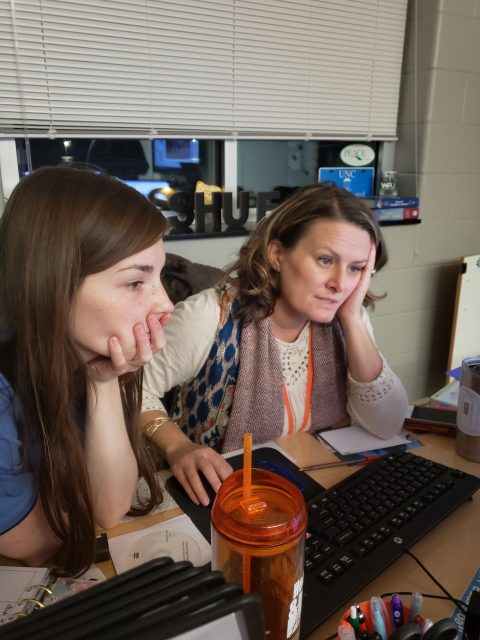 How and why did you decide to go into teaching? Advising?
How and why did you decide to go into teaching? Advising?
I was student body president for two years in high school, and as odd as this sounds, I was delivering Homecoming ballots to teachers (back in the day everything was done on paper). It hit me that I really loved the sorting and organization of it all, and I really loved the high school atmosphere. I was also a good writer and loved to read, so I thought, “Hey, maybe I should become a teacher.” And just like that, I was locked into it. After teaching for two years, I talked my principal into letting me teach a class that would produce a school newspaper. Writing was a passion for me, and I knew the power and voice it had allowed me as a student in high school. I wanted to be able to instill that skill and power in my students.
What was the most difficult part of your first year advising?
Advising newspaper was like going home for me. Advising yearbook was like ending up on a whole new planet. It suddenly mattered if the pictures were clear. I went from low-quality newsprint that we gave away for free to glossy expensive yearbook paper where everything mattered and people were paying big money. I had to figure out how to use real SLR cameras. I had to make the yearbook staff realize that deadlines mattered. I actually started advising the yearbook in January after the teacher left the school, while still advising the school newspaper. They had only submitted 50 pages by then, so I had almost the entire book left to create and submit a month and a half later. The yearbook kids hated me so much because they had been creating a scrapbook, and I was forcing them to become journalists. The most difficult part for me was learning all the ways yearbook was different from newspapers but also teaching my students how to bring good journalism and ethics and fair coverage to the yearbook world at my school.
What made you want to come back for year two?
I love a good challenge. I also wanted to start from the beginning and see if it was any easier. I was still advising the newspaper, so I made the news staff write all the yearbook copy and the yearbook staff learned how to do better photos and design. Year two meant I could start fresh and cultivate the staff I wanted. The old staff members still hated me, but maybe a little less than the year before.
What advice would you give to a first-year adviser?
Decide you’re going to still be there for year five. It takes a LONG time to learn what you need to learn to be good. And it takes a LONG time to teach the kids to be great. I knew where I wanted to go with our yearbook program and knew what changes we needed to make to get there, but I would have been crazy to try to change it all at once. I had to pick the biggest issues and change just those the first year. The next year, those elements were givens, and I could pick a few more new things as a focus. Each year, we improved a few areas until now those are the standards for what we do. This job is so difficult and if you care about it, you will pour so much of yourself and your time into it. You won’t see the benefits of those efforts in those first few years. Each year you will get better and if you quit before year five, you may miss out on that win.
What were some of the factors that have led to your success as an adviser?
While I don’t really recommend it, I am completely self-sacrificing. Some days, I am a better teacher and adviser than a mom or a wife. But I also believe that my children are watching and what they see is a mom who works really hard for what she cares deeply about, a mom who gives her heart to her students because relationships matter and a mom who is a whole person outside of being their mom. I believe that will make them better humans to see their mom embrace her passions, so my success is in part due to the tons of time and energy I put into getting the publications completed. It is also due to the relationships I build with my staff. I give them all the power – they are the majority voices in the conversations. I am honest and open with them, and they get to see me be more of a person rather than just a teacher. My need to change the things that were holding us back and risk losing some staff members in the process helped us get over some early hurdles. I also began to collect great examples of yearbooks from schools across the country. McKinney, Boone, Timber Creek and all the Shawnee Mission schools’ yearbooks have been sitting on our shelves for years. We found books we loved and modeled our next moves after what we felt was great journalism.
What has been your biggest challenge as an adviser?
Keeping all the plates spinning is the biggest challenge. What I love the most about yearbook is the multifaceted roles and job skills that students learn during the production process, but that can be really difficult to manage and teach while still getting all the work done. Every year, I find a new way to spin a plate faster, but then we add another plate to the mix. It’s exciting to teach such a dynamic class with so many moving parts, but sometimes I forget that the new kid doesn’t know yet, and I have to back up and say “ok, let’s sit down and figure this out.” Also, writing receipts. That’s the worst.
Corona quarantine and finishing the book
When was your last day of school? What did you still have to do to finish the book?
Our last day of classes was on March 13. We had submitted about half the book, and had other spreads that were “done” but we were holding for various reasons. When we walked out, there were still 81 pages blank or barely started. We are a chronological book, but we still had a few spreads from as early as October that we hadn’t done yet because they were evergreen topics or features that we had kept putting off. When school closed many of those evergreens dried up, and we had to find new ideas to fill those spreads.
How has your staff managed to finish the book from home?
We are so fortunate to have people in some high places who believe in us and know how hard we work. Our yearbook was on the shortlist of high priorities to consider from our county office, tech department and school Superintendent. They called me on our first day after shutdown and asked what I needed to be able to finish the book. They allowed me to send home the yearbook desktop computers with all of my designers. We create using Online Design, but the designers only had personal laptops, plus the desktops had the Adobe suite loaded in case they needed photoshop or work on images. We also worked on the book by sending 100 million (or close) text messages and meeting as groups or whole staff on Zoom to discuss ideas for spreads. And we didn’t sleep much for those next two weeks before our final deadline.
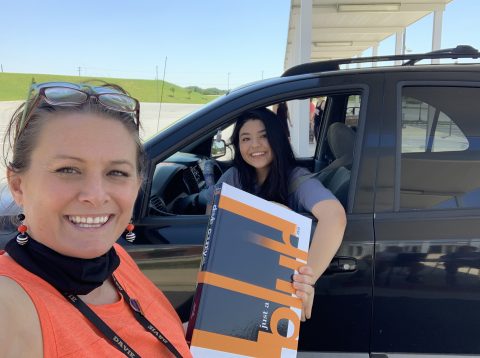 What new coverage did they create to finish the book?
What new coverage did they create to finish the book?
We had a spread called “Locked in the Tower or Never on Campus” which was supposed to be about kids who never leave our main building for classes and compare their day with students who take all their courses as dual enrollment at the community college. We never did the work ahead of closing, plus it seemed odd to cover after closure, but we had already listed that spread title in our table of contents. We decided to write some short copy on those kids, but then added “Would you rather” to the headline. Then we took random photos from throughout the year and paired them, like would you rather play an instrument in front of the entire school or paint the backdrop for the play, and clean up the cafeteria commons after lunch or give blood at the blood drive, etc.? We did a few more moments to remember pages with random photos at the end of our coverage where Spring activities should have gone. One of the easiest spreads that was totally new was “Name that Spot.” Since our campus was closed to students, I went around the entire campus on our first shutdown day and took pictures of random objects inside of classrooms and common spaces. The designers created a collage of the items on the spread and then listed their locations in a key at the bottom. It has become one of our favorites.
When did they finish?
The last pages of the index were submitted on Friday, March 27, which was three days after our final deadline date.
How did you distribute the book?
We distributed them on June 3 and 4 from 12 – 6 p.m. We did it drive-thru style. Our school media staffs were trying to collect the borrowed laptops and textbooks, so we paired our efforts with them. At our first station, students and parents scanned a QR code to fill out information such as their names and what items they were there to drop off and if they also ordered a yearbook. The next stations collected items and fees. If they were cleared at those stations, then a green card was placed on their windshield, and they proceeded to the yearbook pick-up stations. We checked the names, gave them books and took the green cards before they left. My yearbook staff wasn’t allowed to help me, so I enlisted some teacher friends to help. We also requested at the last minute that all of our books be shrink-wrapped for the added safety measure and my co-workers wore gloves and masks as the handed out the books. We did not try to organize the two pickup dates by names but allowed everyone to come as they were able during our two-day, six-hour events. We didn’t have any issues with the flow of traffic or organization.
Tell me about something in your life as an adviser that has made you proud.
The growth I see in my staff each year always makes me especially proud. A fellow teacher asked me this year “Which book do you like the best?” I told her, “I always love the last one.” Every “last one” shows me how much the staff has learned from the previous book. In education, we are constantly asked to compare data and measure growth. Sometimes that’s tough to point to in an English class, but in yearbook, I can compare and point out each area of growth and improvement and identify exactly where we can go next. Even more importantly, my staff can do that now too. They have learned to be objective about their work and see their successes and ways to make the next book stronger. I can’t think of anything better than a student being able to look at their work and see that the effort and time they put into the next work or publication paid off. I’m proud that they’ve learned those skills and that they can now teach new staff members those skills as well. This year, we earned a TarHeel Award from our state scholastic association, their highest honor. That’s a goal we’ve worked especially hard to earn for four years now. While the awards and positive critiques are great and affirming of our hard work, we are most proud when our students, school and community love our book. Their praise of our work is most satisfying to us because it means that we did our job – we captured the memories of the year and made it speak to everyone.
Tell a story about a moment in your career as adviser that you will never forget.
One year, I saved a student’s life. Maybe more than once, figuratively, but one time I literally saved a student’s life. I had a yearbook designer years ago whose mother was a drug addict and the mom had overdosed one night. My student had been at the hospital with her all night and hadn’t slept at all. My student came to school only because she had had enough. She was tired of taking care of her mom all the time, she knew her life was never going to be easy and she had decided that she was going to kill herself that night. But she also wanted to come to school that morning to say goodbye. I never heard her goodbye because as she was telling me about her evening, I wrapped my arms around her, told her how much she was loved and how important she was to me. My yearbook room was separate from my classroom, and we had a couch in there. I told her to lay down on the couch and sleep for the entire school day. I locked the door and kept the staff out when they came for class later. I brought lunch up to her and sent an email to all of her teachers telling them she would be with me. She went home that night and came back the next day a little better. I didn’t know at the time anything about what she had planned to do. It was only at the end of the next year, after she had served as the yearbook EIC, that she told me that what I did that day meant the world to her. It was only five years later when she had graduated college and was preparing to get married that she told me that I had actually saved her life that day with that embrace and that small act of giving her a safe space. I’m proud that the work is important to the kids, but what’s more important to me is that the relationships and lessons publications provide students is life changing.

